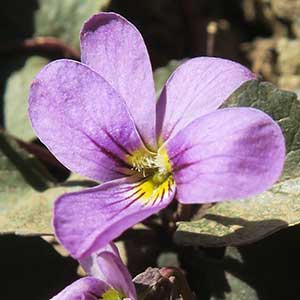|
Flett's violet, Olympic violet, rock violet
|
field pansy, violette de Rafinesque, wild pansy
|
| Plants perennial, caulescent, not stoloniferous, 3–15 cm. |
|
1–3, ascending to erect, mostly glabrous, on caudex from fleshy rhizome. |
|
basal and cauline; basal: 1–3; stipules linear-lanceolate, margins entire or with glandular processes, apex acuminate; petiole 1.5–9.7 cm, mostly glabrous; blade purple-tinted and –veined, broadly reniform to ovate, 0.9–2.4 × 1.2–4 cm, base cordate, margins finely crenate-serrate, eciliate, apex acute to obtuse, surfaces glabrous or sparsely pubescent along veins adaxially; cauline similar to basal except: stipules ovate to lanceolate, margins entire or shallowly laciniate; petiole 0.7–5.9 cm, usually glabrous; blade 0.8–2.1 × 1.2–3.1 cm. |
|
1.8–7.1 cm, usually glabrous. |
1–4.5 cm, glabrous or pubescent. |
sepals lanceolate, margins eciliate, auricles 0.5–1.5 mm; petals soft reddish violet on both surfaces, all with yellow area basally, lower 3 dark violet-veined, lateral 2 bearded, lowest with white around yellow area, 10–15 mm, spur yellow, gibbous, 0.5–2 mm; style head bearded; cleistogamous flowers axillary. |
sepals ovate to lanceolate, margins ciliate or eciliate, auricles 0.5–2 mm; petals white or cream to pale bluish violet on both surfaces, dark purple-veined, lateral 2 longer than sepals, bearded, lowest 8–10 mm, spur white to blue-violet, gibbous, 1–1.5 mm, shorter than or equaling sepal auricles; style head bearded; cleistogamous flowers axillary. |
± spherical, 5–9 mm, glabrous. |
ellipsoid to oblong, 4–7 mm, glabrous. |
dark brown to brownish purple, 2.5–3 mm. |
beige to bronze, 0.3–1.5 mm. |
|
= 34. |
|
|
|
|
| Flowering Jun–Aug. |
Flowering Mar–May. |
| Alpine and subalpine rock crevices, vertical faces, talus slopes |
Prairies, open woodlands, fields, pastures, roadsides, lawns, waste ground |
| 1100–2000 m (3600–6600 ft) |
0–3000 m (0–9800 ft) |
|
WA
|
AL; AR; AZ; CO; CT; DC; DE; FL; GA; IA; ID; IL; IN; KS; KY; LA; MA; MD; MO; MS; NC; NE; NJ; NM; NY; OH; OK; PA; RI; SC; SD; TN; TX; VA; WV; ON; SK
|
Viola flettii is endemic to the Olympic Mountains of northwestern Washington. C. S. McCreary (2005) noted that although morphologically and ecologically distinct, V. cuneata, V. flettii, and V. ocellata are closely related. (Discussion copyrighted by Flora of North America; reprinted with permission.) |
Viola bicolor is the only pansy native to North America (V. B. Baird 1942; J. Clausen et al. 1964; A. E. Radford et al. 1968) and is the only annual Viola species that produces cleistogamous flowers (Baird; A. Gershoy 1934). Roots of V. bicolor have the odor of wintergreen when crushed (W. J. Hayden and J. Clough 1990). (Discussion copyrighted by Flora of North America; reprinted with permission.) |
| FNA vol. 6, p. 131. |
FNA vol. 6, p. 122. |
| Violaceae > Viola |
Violaceae > Viola |
V. adunca, V. affinis, V. arvensis, V. bakeri, V. beckwithii, V. bicolor, V. biflora, V. blanda, V. brittoniana, V. canadensis, V. canina, V. charlestonensis, V. clauseniana, V. cucullata, V. cuneata, V. douglasii, V. egglestonii, V. epipsila, V. frank-smithii, V. glabella, V. guadalupensis, V. hallii, V. hastata, V. hirsutula, V. howellii, V. japonica, V. labradorica, V. lanceolata, V. langsdorffii, V. lithion, V. lobata, V. macloskeyi, V. missouriensis, V. nephrophylla, V. novae-angliae, V. nuttallii, V. ocellata, V. odorata, V. orbiculata, V. palmata, V. palustris, V. pedata, V. pedatifida, V. pedunculata, V. pinetorum, V. praemorsa, V. primulifolia, V. prionantha, V. pubescens, V. purpurea, V. quercetorum, V. renifolia, V. riviniana, V. rostrata, V. rotundifolia, V. sagittata, V. selkirkii, V. sempervirens, V. septemloba, V. sheltonii, V. sororia, V. striata, V. subsinuata, V. tomentosa, V. tricolor, V. trinervata, V. tripartita, V. umbraticola, V. utahensis, V. vallicola, V. villosa, V. walteri |
V. adunca, V. affinis, V. arvensis, V. bakeri, V. beckwithii, V. biflora, V. blanda, V. brittoniana, V. canadensis, V. canina, V. charlestonensis, V. clauseniana, V. cucullata, V. cuneata, V. douglasii, V. egglestonii, V. epipsila, V. flettii, V. frank-smithii, V. glabella, V. guadalupensis, V. hallii, V. hastata, V. hirsutula, V. howellii, V. japonica, V. labradorica, V. lanceolata, V. langsdorffii, V. lithion, V. lobata, V. macloskeyi, V. missouriensis, V. nephrophylla, V. novae-angliae, V. nuttallii, V. ocellata, V. odorata, V. orbiculata, V. palmata, V. palustris, V. pedata, V. pedatifida, V. pedunculata, V. pinetorum, V. praemorsa, V. primulifolia, V. prionantha, V. pubescens, V. purpurea, V. quercetorum, V. renifolia, V. riviniana, V. rostrata, V. rotundifolia, V. sagittata, V. selkirkii, V. sempervirens, V. septemloba, V. sheltonii, V. sororia, V. striata, V. subsinuata, V. tomentosa, V. tricolor, V. trinervata, V. tripartita, V. umbraticola, V. utahensis, V. vallicola, V. villosa, V. walteri |
|
V. kitaibeliana var. rafinesquei, V. rafinesquei |
| Piper: Erythea 6: 69. (1898) |
Pursh: Fl. Amer. Sept. 1: 175. (1813) |
| |


